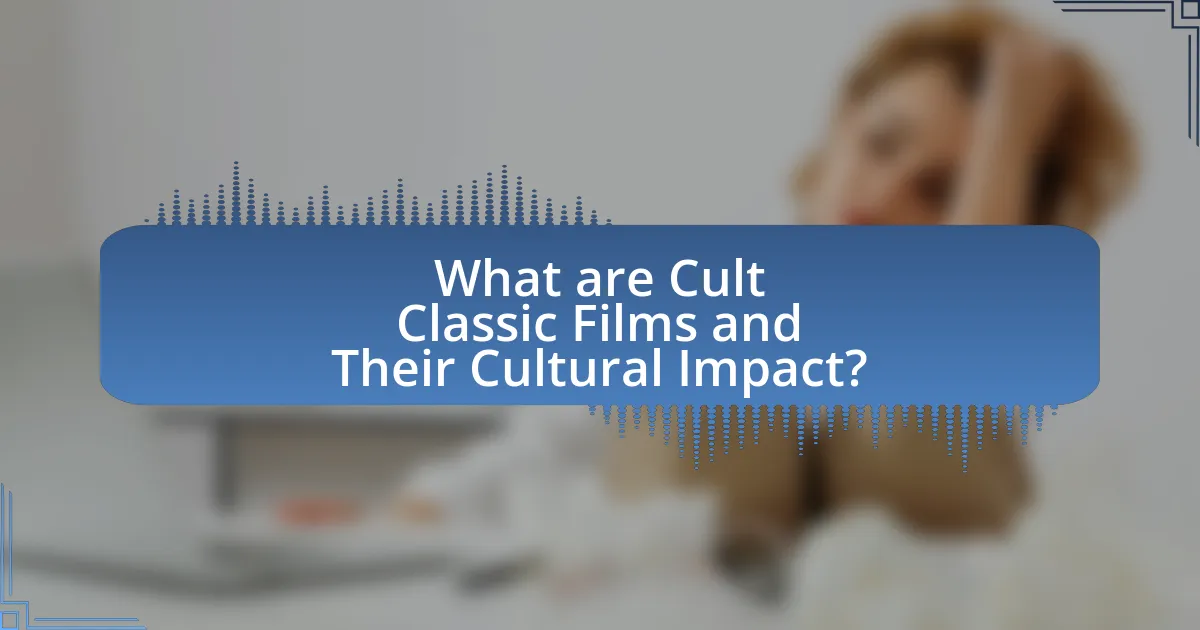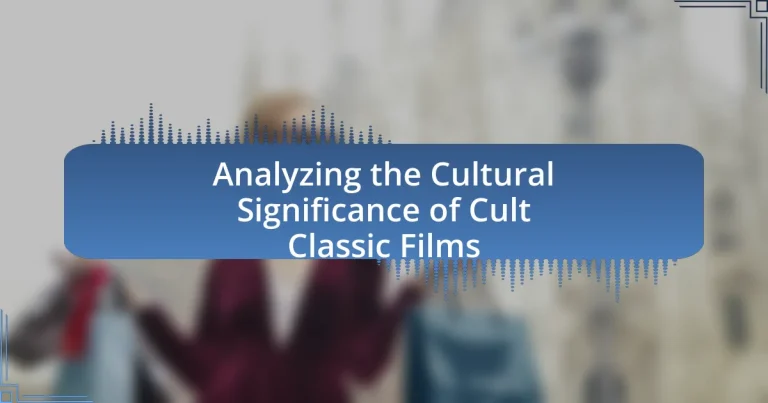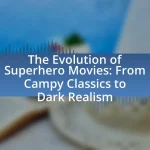Cult classic films are defined as movies that, despite initial commercial failure or limited mainstream appeal, cultivate a dedicated fanbase over time. This article analyzes the cultural significance of cult classics, exploring their unique storytelling, unconventional themes, and the passionate communities that form around them. Key examples such as “The Rocky Horror Picture Show” and “Fight Club” illustrate how these films challenge societal norms and provoke discussions on identity and consumerism. The article also examines the ways audiences engage with cult classics, the themes they convey, and their influence on contemporary filmmaking and popular culture.

What are Cult Classic Films and Their Cultural Impact?
Cult classic films are movies that, despite initial commercial failure or limited mainstream appeal, develop a dedicated and passionate fanbase over time. These films often feature unconventional storytelling, unique characters, or controversial themes that resonate with specific audiences, leading to their enduring popularity. For example, “The Rocky Horror Picture Show,” released in 1975, became a cultural phenomenon through midnight screenings and audience participation, illustrating how cult classics can influence social behaviors and community bonding. Additionally, cult classics like “Fight Club” and “The Big Lebowski” have sparked discussions on identity, consumerism, and masculinity, showcasing their significant cultural impact beyond mere entertainment.
How do we define a cult classic film?
A cult classic film is defined as a movie that has developed a dedicated and passionate fanbase, often despite initial commercial failure or critical disapproval. These films typically feature unique themes, unconventional storytelling, or distinctive styles that resonate with specific audiences, leading to a lasting cultural impact. For example, films like “The Rocky Horror Picture Show” and “Donnie Darko” have gained cult status due to their eccentric narratives and strong community engagement, often resulting in midnight screenings and fan conventions.
What characteristics distinguish cult classic films from mainstream cinema?
Cult classic films are distinguished from mainstream cinema by their unique storytelling, unconventional themes, and dedicated fanbases. Unlike mainstream films, which often prioritize broad appeal and commercial success, cult classics frequently explore niche subjects, subversive humor, or experimental narratives that resonate deeply with specific audiences. For example, films like “The Rocky Horror Picture Show” and “Donnie Darko” have developed loyal followings due to their distinctive styles and themes that challenge societal norms. Additionally, cult classics often gain popularity over time through word-of-mouth and midnight screenings, contrasting with the immediate box office success typically associated with mainstream films. This enduring appeal is evidenced by the continued relevance and cultural impact of such films, as they inspire fan events, merchandise, and community engagement, further solidifying their status within film history.
Why do certain films achieve cult status over others?
Certain films achieve cult status over others due to their unique blend of unconventional storytelling, memorable characters, and strong community engagement among fans. Films like “The Rocky Horror Picture Show” and “Donnie Darko” exemplify this phenomenon, as they often feature themes that resonate deeply with niche audiences, creating a sense of belonging and shared experience. Additionally, the marketing strategies and grassroots movements surrounding these films, such as midnight screenings and fan conventions, further solidify their cult status by fostering a dedicated fanbase that actively participates in the film’s legacy.
What role do cult classic films play in popular culture?
Cult classic films serve as a significant cultural touchstone within popular culture by fostering dedicated fan communities and influencing mainstream media. These films often challenge conventional storytelling and aesthetics, creating a unique space where audiences can engage with unconventional narratives and characters. For instance, films like “The Rocky Horror Picture Show” and “Donnie Darko” have developed loyal followings, leading to interactive screenings and fan conventions that celebrate their distinctiveness. This engagement not only preserves the films’ legacies but also inspires new works in various genres, demonstrating their lasting impact on contemporary cinema and cultural discourse.
How do cult classics influence contemporary filmmaking?
Cult classics influence contemporary filmmaking by establishing unique narrative styles, character archetypes, and subversive themes that resonate with modern audiences. These films often challenge conventional storytelling, as seen in works like “The Rocky Horror Picture Show,” which introduced a blend of genres and interactive viewing experiences. Their enduring popularity encourages filmmakers to experiment with unconventional plots and aesthetics, as evidenced by the resurgence of retro styles in films like “It Follows” and “The Cabin in the Woods.” Additionally, cult classics foster dedicated fan communities that drive demand for similar content, influencing studios to greenlight projects that echo these beloved films. This cyclical relationship between cult classics and contemporary cinema highlights their significant role in shaping current filmmaking trends.
In what ways do cult classic films reflect societal values and issues?
Cult classic films reflect societal values and issues by serving as cultural touchstones that encapsulate the prevailing attitudes, fears, and aspirations of their time. For instance, films like “The Rocky Horror Picture Show” challenge traditional gender roles and sexual norms, reflecting the sexual liberation movement of the 1970s. Similarly, “Fight Club” critiques consumerism and masculinity, resonating with the disillusionment of the late 1990s and early 2000s. These films often gain a dedicated following due to their subversive themes, which resonate with marginalized groups, thereby highlighting societal tensions and shifts. The enduring popularity of such films indicates their role in shaping and reflecting cultural discourse, as evidenced by their continued relevance in discussions about identity, politics, and social justice.

How do Audiences Engage with Cult Classic Films?
Audiences engage with cult classic films through active participation, community building, and repeated viewings. This engagement often manifests in organized screenings, fan conventions, and online forums where viewers discuss themes, quotes, and characters. For example, films like “The Rocky Horror Picture Show” have established a tradition of audience interaction during screenings, where viewers dress up and perform along with the film, enhancing the communal experience. Additionally, cult classics often inspire fan art, merchandise, and social media discussions, further solidifying their cultural impact and fostering a dedicated fanbase.
What motivates audiences to embrace cult classic films?
Audiences are motivated to embrace cult classic films due to their unique blend of nostalgia, subversive themes, and community engagement. Nostalgia plays a significant role, as many viewers have personal connections to these films from their youth, creating a sense of comfort and familiarity. Subversive themes often challenge mainstream norms, appealing to audiences seeking alternative narratives and experiences. Additionally, cult classics foster a strong sense of community among fans, who often participate in screenings, discussions, and fan events, reinforcing their shared passion. This communal aspect is evidenced by the enduring popularity of films like “The Rocky Horror Picture Show,” which has maintained a dedicated following through interactive midnight screenings since its release in 1975.
How does nostalgia contribute to the popularity of cult classics?
Nostalgia significantly contributes to the popularity of cult classics by evoking emotional connections and shared memories among audiences. This emotional resonance often leads to a dedicated fan base that cherishes these films for their ability to transport viewers back to specific moments in their lives, reinforcing a sense of identity and belonging. Research indicates that nostalgia can enhance the enjoyment of media, as seen in a study published in the Journal of Consumer Research, which found that nostalgic feelings can increase positive attitudes toward products and media, including films. Consequently, cult classics thrive on this nostalgia, as they often represent a bygone era or cultural phenomenon that resonates deeply with fans, ensuring their continued relevance and popularity over time.
What community aspects arise from cult classic film fandoms?
Cult classic film fandoms foster strong community aspects such as shared identity, social interaction, and collective memory. Fans often bond over their appreciation for specific films, creating a sense of belonging that transcends geographical boundaries. This shared enthusiasm leads to the formation of fan clubs, online forums, and social media groups where members engage in discussions, share fan art, and organize events like screenings or conventions. Research indicates that these interactions enhance social ties and provide emotional support among fans, reinforcing their connection to the film and each other. For example, the annual Rocky Horror Picture Show screenings have become a cultural phenomenon, illustrating how communal experiences around cult classics can strengthen fan relationships and create lasting traditions.
How do cult classic films foster viewer interaction?
Cult classic films foster viewer interaction through their unique storytelling, memorable characters, and dedicated fan communities. These films often invite audiences to engage in discussions, share interpretations, and participate in events like screenings or cosplay, creating a sense of belonging among fans. For instance, films like “The Rocky Horror Picture Show” encourage audience participation through live performances and sing-alongs, which enhances the communal viewing experience. Additionally, the internet has amplified this interaction, allowing fans to create and share content, such as fan art and theories, further solidifying their connection to the film and each other. This dynamic interaction not only deepens the viewer’s appreciation of the film but also cultivates a vibrant subculture around it.
What are the common practices of cult film screenings and events?
Common practices of cult film screenings and events include interactive audience participation, themed dress codes, and post-screening discussions. These practices enhance the viewing experience by fostering a sense of community among fans. For instance, audience participation often involves shouting lines, bringing props, or engaging in synchronized actions, which can be traced back to the midnight screenings of “The Rocky Horror Picture Show” in the 1970s. Additionally, themed dress codes encourage attendees to come dressed as characters from the film, further immersing them in the cult experience. Post-screening discussions allow fans to analyze and share their interpretations, reinforcing the film’s cultural significance and creating a platform for ongoing dialogue.
How do online platforms enhance the cult film experience?
Online platforms enhance the cult film experience by providing accessibility, community engagement, and curated content. These platforms, such as streaming services and social media, allow fans to easily discover and watch cult films that may not be available through traditional distribution channels. For instance, platforms like Criterion Channel and Shudder specialize in niche genres, offering a wide selection of cult classics that cater to specific audiences.
Additionally, online platforms foster community engagement through forums, social media groups, and fan-driven content, enabling discussions and shared experiences among fans. This interaction amplifies the cult status of films, as seen in the active online communities surrounding films like “The Room” and “Rocky Horror Picture Show.”
Moreover, algorithms on streaming services often recommend cult films based on user preferences, further enhancing the viewing experience by connecting fans with similar tastes. This data-driven approach not only increases visibility for lesser-known films but also solidifies their cultural significance within the broader cinematic landscape.

What are the Key Themes and Messages in Cult Classic Films?
Key themes and messages in cult classic films often revolve around rebellion, individuality, and societal critique. These films frequently challenge mainstream norms and conventions, presenting alternative perspectives on culture and identity. For instance, “The Rocky Horror Picture Show” explores themes of sexual liberation and nonconformity, while “Fight Club” critiques consumerism and masculinity. The enduring popularity of these films can be attributed to their ability to resonate with audiences seeking authenticity and connection to countercultural movements. Cult classics often serve as a reflection of societal anxieties and aspirations, making them significant in cultural discourse.
What recurring themes can be found in cult classic films?
Recurring themes in cult classic films include anti-establishment sentiments, subversion of traditional narratives, and exploration of identity. These films often challenge societal norms and conventions, reflecting a countercultural ethos that resonates with audiences. For instance, “The Rocky Horror Picture Show” embodies the celebration of sexual liberation and nonconformity, while “Fight Club” critiques consumerism and masculinity. Additionally, themes of existentialism and absurdity are prevalent, as seen in “The Big Lebowski,” which presents a laid-back protagonist navigating a chaotic world. These thematic elements contribute to the films’ lasting appeal and cultural significance, as they invite viewers to question reality and embrace individuality.
How do these themes resonate with audiences across different generations?
Themes in cult classic films resonate with audiences across different generations by addressing universal human experiences such as love, identity, and rebellion. These themes transcend time, allowing viewers from various age groups to connect emotionally and intellectually. For instance, films like “The Breakfast Club” explore adolescent struggles, appealing to both young viewers and adults reflecting on their youth. Additionally, the nostalgia associated with these films often evokes shared cultural memories, further enhancing their relevance across generations. Research indicates that films with relatable themes can foster intergenerational dialogue, as seen in studies by the American Psychological Association, which highlight the impact of shared media experiences on familial relationships.
What social or political messages are often conveyed in cult classics?
Cult classics often convey social or political messages that challenge societal norms and provoke critical thought. For instance, films like “A Clockwork Orange” critique authoritarianism and the loss of free will, while “The Rocky Horror Picture Show” promotes sexual liberation and acceptance of diverse identities. These films resonate with audiences by addressing issues such as conformity, rebellion, and the complexities of human nature, reflecting the cultural and political climates of their times. The enduring popularity of these films underscores their ability to engage viewers in discussions about morality, identity, and societal change.
How do cult classic films challenge traditional storytelling?
Cult classic films challenge traditional storytelling by subverting conventional narrative structures and character archetypes. These films often embrace non-linear plots, unconventional endings, and anti-heroes, which defy audience expectations. For example, “The Rocky Horror Picture Show” employs a campy aesthetic and breaks the fourth wall, inviting viewers to engage with the film in a participatory manner, contrasting with the passive consumption typical of mainstream cinema. Additionally, cult classics like “Fight Club” critique consumer culture and masculinity, using unreliable narrators to distort reality and provoke thought, further distancing themselves from traditional storytelling norms.
What narrative techniques are commonly used in cult classics?
Cult classics commonly employ narrative techniques such as non-linear storytelling, unreliable narrators, and metafiction. Non-linear storytelling disrupts chronological order, engaging viewers through fragmented timelines, as seen in films like “Pulp Fiction.” Unreliable narrators create ambiguity and challenge audience perceptions, exemplified in “Fight Club,” where the protagonist’s mental state distorts reality. Metafiction blurs the line between fiction and reality, inviting self-reflection, as demonstrated in “The Rocky Horror Picture Show,” which acknowledges its own theatricality. These techniques contribute to the unique appeal and lasting impact of cult classics, fostering deep audience engagement and discussion.
How do cult classics subvert genre conventions?
Cult classics subvert genre conventions by intentionally breaking established narrative and stylistic norms, often leading to unexpected plot developments and character arcs. For instance, films like “The Rocky Horror Picture Show” challenge traditional horror and musical genres by blending elements of camp, parody, and social commentary, which diverges from typical genre expectations. This subversion often resonates with audiences who appreciate the films’ unique perspectives, creating a dedicated fan base that celebrates their unconventional approaches. Additionally, cult classics frequently employ self-referential humor and meta-narratives, further distancing themselves from conventional storytelling and inviting viewers to engage with the material in a more critical and participatory manner.
What are some practical tips for exploring cult classic films?
To explore cult classic films effectively, start by identifying key titles that have garnered a dedicated following, such as “The Rocky Horror Picture Show” or “Donnie Darko.” Engaging with these films involves watching them in a social setting, as many cult classics thrive on audience interaction, enhancing the viewing experience. Additionally, researching the historical context and production background of these films can provide deeper insights into their cultural significance. For instance, understanding the countercultural movements of the 1970s can illuminate why certain films became cult favorites during that era. Participating in fan communities, whether online or in-person, can also enrich your exploration, as these groups often share interpretations and host events that celebrate the films.


